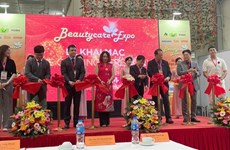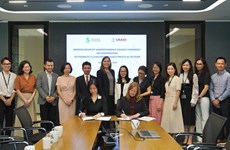Utilising hydropower resources for socio-economic growth
Vietnam has more than 3,450 river and stream systems of different sizes theoretically capable of generating electricity with a total potential production capacity of 35,000 MW and 300 billion kWh of electricity a year. The northern region accounts for some 60 percent, the central some 27 percent, and the southern 13 percent. However, with feasibility taken into account, the country can utilise about 26,000 MW or 100 billion kWh of electricity a year.
Vietnam has more than 3,450 river and stream systems
of different sizes theoretically capable of generating electricity with
a total potential production capacity of 35,000 MW and 300 billion kWh
of electricity a year. The northern region accounts for some 60 percent,
the central some 27 percent, and the southern 13 percent. However, with
feasibility taken into account, the country can utilise about 26,000 MW
or 100 billion kWh of electricity a year.
Before 1990, some
large- and small-scaled hydropower projects like Hoa Binh (1,920 MW),
Thac Ba (120 MW), Da Nhim (160 MW) and Tri An (400 MW) and a number of
small and micro hydropower plants were built.
After 1990,
according to the Government’s guidelines for the Vietnam Electricity
Industry Development Strategy and National Electric Power Development
Plan, renewable energy sources (wind, solar, hydro power, etc.) were
given investment priority, especially hydropower projects with extra
benefits (water supply, flood prevention, drought prevention, etc).
Small-scaled hydropower plants were invested to meet growing energy
demand in the country. On that basis, the Ministry of Industry and Trade
in collaboration with involved ministries, agencies and localities
carried out researches on hydropower development in potential rivers and
streams.
By now, the country-wide hydropower development
planning has been established and approved, thus laying the groundwork
for formulating investment projects. According to approved plans, the
country now has 815 hydropower projects with a combined capacity of
24,324.3 MW. Of these, 268 projects have been put into operation
(14,240.5 MW); 205 projects are construction (6,198.8 MW) and expected
to be operated before 2017. The storage capacity for downstream regions
is 10.51 billion cubic metres.
On large rivers, 113 cascaded
hydropower projects have been approved for construction with a total
capacity of 18,006 MW. Most projects have been built. As many as 56
projects have been brought into operation while the rest are expected to
be completed and operated by 2017 and 17 projects are being studied.
The above hydroelectric plants have supplied electricity, regulated
water flows and controlled flooding for downstream areas. Some projects
have been adjusted to improve investment efficiency, mitigate
environmental and social impacts and fit with new plans and other
prioritised projects.
The investment and construction of
hydropower projects has importantly ensured energy security and promoted
the country’s socioeconomic development towards industrialisation and
modernisation. In 2012, hydropower plants accounted for 48.26 percent of
production capacity and 43.9 percent of power output. This is a clean
renewable energy source generated at a lower cost than other power
sources.
The investment, construction and operation of
hydropower projects has created many jobs. The formation of
hydroelectric reservoirs has also importantly and actively regulated
water for livelihood and agriculture, reduced downstream flooding,
improved environment, and develop tourism, aquaculture and
transportation.
Hydropower reservoirs with a total storage
capacity of tens of billions cubic metres of water have played an
important role in storing and supplying water in dry seasons and
reducing flooding to ensure better livelihood, production and
environmental protection for the downstream. According to the Ministry
of Natural Resources and Environment, hydropower reservoirs will account
for about 86 percent of total reservoir capacity of the country (56
billion cubic metres versus 65 billion cubic metres in total).
The reservoir system is extremely important to water resources security.
While building hydroelectric plants, many socioeconomic
infrastructure works like power grids, roads, schools, clinics and
cultural houses in resettlement areas have been built or upgraded to
serve quicker socioeconomic and cultural development.
However,
the investment and construction of hydroelectric projects have also
affected local people. Resettled residents are vulnerable as their
living space and farming area are narrowed. These major issues need to
be addressed soon. The government is directing relevant ministries and
branches to carry out projects to stabilise production and livelihood
for resettled people.
To ensure sustainable hydropower
development and environmental and social protection, the Prime Minister
has directed ministries, branches and localities involved to operate
hydropower plants as processes approved, ensure power generation
efficiency, and regulate sufficient water sources for the downstream.-VNA













